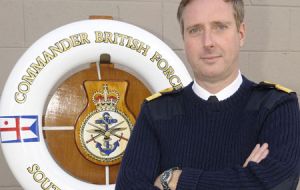MercoPress. South Atlantic News Agency
Falklands’ veteran, Commander of British Forces South Atlantic Islands
 Among other vessels Commodore Phillip Thicknesse served on HMS Fearless and HMS Leeds Castle, Falklands patrol ship
Among other vessels Commodore Phillip Thicknesse served on HMS Fearless and HMS Leeds Castle, Falklands patrol ship A former Royal Navy commander of the coalition Naval Training Team re-building the Iraqi Navy at Umm Qasr Naval Base and Falklands’ war veteran is the new Commander British Forces Falkland Islands.
Captain Thicknesse was awarded the US bronze star for his work at Umm Qasr.
Philip Thicknesse joined the Royal Navy in 1978, having been educated at Downside School. After passing out of Dartmouth he read History at Lancaster University, before returning to the Fleet in 1981. He served in the Assault Ship HMS FEARLESS during the Falklands war and was the second in command of the Argentine Prize YEHUIN.
Following a tour as the Gunnery Officer of HMS JERSEY, a Fishery Protection Vessel, he transferred to the Fleet Air Arm as a helicopter pilot. Awarded the Kelmsley Trophy as the top Anti Submarine Warfare pilot graduating from Flying Training in 1986, he joined 820 Naval Air Squadron, flying ASW Seakings from HMS ARK ROYAL. In late 1986 he survived a ditching, following a catastrophic mechanical failure, escaping from the wreckage underwater with two crewmates.
The following year he trained as a Principal Warfare Officer and served as the Underwater Warfare Officer in the Destroyer HMS BIRMINGHAM, before returning to the Fleet Air Arm and the Lynx helicopter as the Squadron Aviation Officer for the Ninth Frigate Squadron and Flight Commander in HMS NORFOLK, the first Type 23 Frigate.
In 1993 he attended the Naval Staff Course at Greenwich, where he read for an MA in Defence Studies. From there he joined the Royal Yacht BRITANNIA as First Lieutenant, following which he commanded HMS LEEDS CASTLE, the Falklands Patrol Ship. Promoted Commander in 1996, he joined the Directing Staff at the Royal Military College of Science in an Army Air Corps post. During his final year at the college, he co-authored and published Military Rotorcraft, A Brassey's textbook. Appointed back to sea, he commanded the Frigate HMS WESTMINSTER and conducted a wide range of national tasking and a NATO deployment with the Standing Naval Force Atlantic. He was then appointed as the MA to the Second Sea Lord.
Promoted Captain in 2003, he joined the MOD as Director of the Defence Crisis Management Centre and AD Contingent Operations in the Directorate of Joint Commitments. Following that, in 2006 he deployed to Iraq to command the coalition Naval Training Team re-building the Iraqi Navy at Umm Qasr Naval Base.
On his return to the UK he took command of Royal Naval Air Station Culdrose, home to 5 aircraft types, 11 squadrons and 3,000 personnel. Leaving Culdrose in late 2008, he then spent one year as Director of the Maritime Warfare Centre before being selected for promotion to Commodore and appointed as Commander British Forces South Atlantic Islands in December 09.
By Lisa Watson – Stanley




Top Comments
Disclaimer & comment rulesCommenting for this story is now closed.
If you have a Facebook account, become a fan and comment on our Facebook Page!